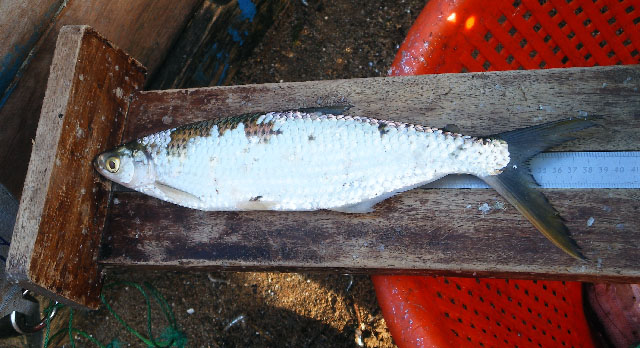| Alestidae (African tetras) |
| 43 cm TL (male/unsexed); 40 cm TL (female); max.weight: 500.0 g; max. reported age: 6 years |
|
benthopelagic; pH range: 6.5 - 7.8; dH range: 30, potamodromous |
| Africa: Senegal, Gambia, the coastal basins of the Côte d'Ivoire (Comoé, Bandama and Sassandra), Volta, Niger/Benué and Chad basin (Ref. 2880, 81279). Also present in Nile, Omo, Lake Albert and Lake Turkana (Ref. 2880). Three populations - previously as subspecies - may be distinguished by slight morphological differences but they have the same ecological charasterics: in Nile River, Lake Albert, Omo River and Lake Turkana ('baremoze'); in Senegal River, Gambia River, Tominé River, Volta basin, Niger basin and Chad basin ('soudaniensis'); in coastal basins of Côte d'Ivoire, namely Sassandra River, Bandama River and Comoé River ('eburneensis') (Ref. 42019). |
|
Dorsal spines (total): 0-0; Dorsal soft rays (total): 10-10; Anal spines: 0-0; Anal soft rays: 22-31; Vertebrae: 41-49. Diagnosis: at least 30 gill rakers on lower limb of first gill arch (30-41); 38-51 lateral line scales, with 7.5-9.5 above and 3.5 below; anal fin with three simple rays and 19-28 branched rays; dorsal-fin origin distinctly behind level of pelvic-fin insertions (Ref. 2759, 81279).
Description: external border of anal fin curves slightly and regularly concave in females; forms an anterior lobe in males with some rays clearly longer; well developed fontanel (Ref. 2759). 41-49 vertebrae (Ref. 2880, 81279).
Colouration: silver/greyish colored with blue-grey back and white belly, greyish fins, entirely covered with scales; Sudanese fishes have orange colors on the inferior lobe of the caudal fin; caudal fork finely edged with black; no precaudal or humeral spots (Ref. 2759, 2880, 81279). |
| Mainly diurnal. There is considerable flexibility in its diet, A. baremoze shifts from zooplankton to zoobenthos, detritus and macrophytes as plankton densities decline (Ref. 28714). Occurs at a temperature range of 14.6-35.0°C. In the Malamfatori area (Tchad), seine-net fishery on the River Yobe depends on seasonal upstream (from Lake Chad) and downstream migration during the flood (August-December) and dry (January-March) seasons, respectively. Also, there is an intensive gillnet fishery from July-October at the river mouth. A. baremoze moves offshore (in Lake Chad) beginning March. |
|
(Ref. 96402)
|
| harmless |
|
Type locality of the syntypes of Myletes baremoze: 'Thèbes' (Ref. 89799). Known from Nile River (Ref. 89799, 42019). This species used to be found along the whole Nile River, in delta lakes, the Rashid branch and the Lower Nile, but it is now restricted to the Upper Nile River above the High Dam construction (Ref. 51850). |
Source and more info: www.fishbase.org. For personal, classroom, and other internal use only. Not for publication.
Page created by Jen, 05.08.02,
php script by kbanasihan 06/09/2010 ,
last modified by
dsantos, 20/08/10

